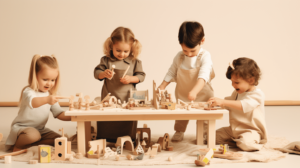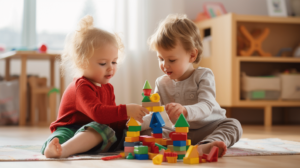
Sibling Relationships – Tips for Encouraging Bonding
Discover effective tips for nurturing sibling relationships and fostering a strong bond between siblings. Create lasting connections and promote harmony.
Welcome to the world of outdoor adventures for toddlers and siblings! Are you looking for ways to keep your little ones active and entertained? Look no further! In this article, we’ll explore various activities that will not only get your kids moving but also foster a sense of adventure and exploration.
In today’s technology-driven world, children are spending more time indoors and less time engaging in physical activity. With the rise of screens and sedentary lifestyles, it’s crucial to prioritize outdoor play for the health and well-being of our little ones. Outdoor play not only provides a fun and exciting experience but also offers numerous benefits for their physical, social, and emotional development.
So, are you ready to step into the great outdoors with your toddlers and their siblings? Let’s dive in and discover the wonderful world of outdoor adventures!

Did you know that less than 20% of the world’s adolescents are physically active enough? With the rise of sedentary lifestyles and increased screen time, it’s no surprise that many children and teenagers are not getting the recommended amount of physical activity. Being physically active is crucial for overall health and well-being, and it’s essential for children to develop healthy habits from a young age.
It’s not just adolescents who are struggling with physical activity. In a 2015 study, it was found that roughly 50% of preschoolers met the physical activity recommendations. This means that half of the young children in the study were not getting enough exercise to support their growth and development. Encouraging physical activity in the early years is vital for laying a strong foundation for a healthy lifestyle.
The amount of time children spend playing outside has dramatically decreased over the years. American children, for example, now spend 35% less time playing outside freely than their parents did when they were children. This decline can be attributed to various factors, including increased screen time, safety concerns, and a lack of access to outdoor spaces. As a result, children are missing out on the many benefits that outdoor play provides.
Despite the decline in outdoor playtime, there is still a significant interest in outdoor recreation activities. In 2020, 53% of Americans ages 6 and over participated in outdoor recreation at least once. This includes activities such as hiking, biking, and camping. Engaging in outdoor activities is a fantastic way to enjoy the natural world and get the physical exercise needed to stay healthy. Encouraging children to participate in outdoor recreation can help combat the decrease in physical activity levels.
“Children’s physical activity is declining, but we can work together to change that and promote a healthier and more active lifestyle for our kids.”
So, what can we do to address the current state of children’s physical activity and promote a more active lifestyle? One of the solutions lies in encouraging outdoor play and providing opportunities for children to engage in physical activities. By understanding the benefits of outdoor play and addressing the obstacles, parents and caregivers can make a positive impact on their children’s health and well-being. Let’s explore how outdoor play can make a difference!
Outdoor play is not only a fun and enjoyable activity for children, but it also offers numerous benefits for their physical, mental, and emotional development. In today’s technology-driven world, where screen time dominates leisure activities, it’s more important than ever to prioritize outdoor play for children. Let’s explore some of the key benefits that make outdoor play essential for the growth and well-being of children:
One of the primary benefits of outdoor play is the improvement in coordination and strength that it offers. When children engage in activities like running, jumping, climbing, and playing sports outdoors, they develop their motor skills and strengthen their muscles. These activities require balance, agility, and hand-eye coordination, which contribute to the overall development of their physical abilities.
Outdoor play and physical activity play a significant role in reducing the risk of childhood obesity and weight-related health concerns. Regular engagement in outdoor activities helps children burn calories, maintain a healthy weight, and build a strong foundation for a physically active lifestyle. By encouraging children to spend more time outdoors and participate in active play, we can help combat the growing epidemic of childhood obesity.
Playing outdoors provides opportunities for children to interact and socialize with others, including siblings, friends, and even neighborhood kids. These social interactions help develop crucial social skills, such as communication, teamwork, cooperation, and problem-solving. Additionally, outdoor play has been found to have a positive impact on children’s mood and emotional well-being. The fresh air, sunshine, and physical activity stimulate the release of endorphins, which are known as the “feel-good” hormones. This can help reduce stress, anxiety, and improve overall mental health.
Engaging in outdoor play and accomplishing physical challenges can significantly boost a child’s self-esteem and confidence. When children take risks, overcome obstacles, and achieve small victories in their outdoor adventures, they gain a sense of accomplishment and belief in their abilities. Outdoor play allows children to explore their potential, build resilience, and develop a positive self-image. The confidence they gain through outdoor play can have a lasting impact on their overall well-being and future success.
By understanding and appreciating the benefits of outdoor play, we can encourage children to spend more time outdoors and engage in physical activities. Incorporating outdoor play into children’s daily routines is essential for their holistic development and overall well-being. So, let’s prioritize outdoor play, inspire children to explore the world around them, and create a generation of active and thriving individuals!
When it comes to achieving the recommended level of physical activity for children, there are a few obstacles that can get in the way. In today’s digital age, children are spending more time in front of screens than ever before. This shift in behavior has led to a decrease in outdoor play and physical activity. Here are some of the main obstacles that parents and caregivers face when trying to encourage their children to be more active:
One of the biggest obstacles is the competition between screen time and outdoor play. With the rise of smartphones, tablets, and video games, children are often drawn to the allure of screens. The average American child spends four to seven minutes a day in unstructured outdoor play compared to seven or more hours in front of a screen. This sedentary behavior can have a negative impact on their physical health and overall well-being.
Another obstacle is the simple fact that many children are not meeting the recommended guidelines for physical activity. According to research, only about 1 in 4 children get the recommended 60 minutes of physical activity per day. This lack of physical activity puts them at a higher risk for health issues such as obesity, cardiovascular disease, and diabetes.
It’s important for parents and caregivers to be aware of these obstacles and take steps to overcome them. Here are a few strategies that can help:
By addressing these obstacles and implementing strategies to overcome them, parents and caregivers can help their children achieve the recommended level of physical activity. Remember, the goal is not just to get your child moving, but to instill a lifelong love for physical activity and a healthy lifestyle.
Children nowadays are spending more and more time indoors, engaging in sedentary activities like watching TV or playing video games. It’s no surprise that this lack of physical activity has led to a rise in childhood obesity and other health concerns. That’s why it’s crucial to emphasize the importance of outdoor play and independent mobility for children’s well-being.
Outdoor play and independent mobility refer to children having the freedom to explore and interact with their natural environment without constant adult supervision. It involves activities like running, jumping, climbing, cycling, and playing ball games. This type of play is not only fun but also essential for children’s physical, cognitive, and emotional development.
Here are a few reasons why outdoor play and independent mobility are so important for children:
Studies support the importance of outdoor play and independent mobility for thriving children and neighborhoods. Research has shown that children who have access to safe and stimulating outdoor play spaces have better physical, cognitive, and social-emotional development. They are more likely to be active throughout their lives and have a greater connection to nature and their community.
Unfortunately, there are some obstacles that prevent children from achieving recommended physical activity levels and enjoying outdoor play to the fullest. These obstacles include:
In conclusion, outdoor play and independent mobility are vital for children’s physical, cognitive, and emotional development. By providing children with the opportunity to engage in unstructured outdoor play, we are setting them up for a healthier, happier, and more successful future. So let’s encourage our little ones to put down their devices, step outside, and embrace the wonders of nature!
Welcome to the world of outdoor adventures for toddlers and siblings! As a parent or caregiver, you know how important it is for children to engage in physical activity and explore the great outdoors. In this article, we will explore the benefits of outdoor play, the obstacles in achieving recommended physical activity, and most importantly, we will provide you with fun and engaging activity ideas for your little ones. So, let’s dive in and get ready for some active play!
Outdoor play is not just about keeping your children active, it also offers a wide range of benefits for their development. Here are some key benefits of outdoor play:
While outdoor play has numerous benefits, there are obstacles that hinder children from achieving recommended levels of physical activity:
Numerous studies support the importance of outdoor play and independent mobility for thriving children and neighborhoods. Giving children the opportunity to play outside, explore their surroundings, and develop independence fosters their physical, cognitive, and emotional development. It also contributes to the creation of vibrant and connected communities.
Now, let’s get to the exciting part – the activity ideas for toddlers and siblings:
These are just a few examples of the many activities you can enjoy with your toddlers and siblings. Remember to prioritize safety, choose age-appropriate activities, and most importantly, have fun!
In conclusion, outdoor adventures for toddlers and siblings are not only a great way to keep children physically active but also contribute to their overall development. By providing opportunities for outdoor play, you are giving your little ones the chance to explore, learn, and grow. So, put on your adventure hats, step outside, and embark on thrilling journeys with your children. Happy active play!
In conclusion, outdoor play is vital for the overall development and well-being of children. Engaging in physical activities and active play not only promotes physical fitness but also contributes to the growth of coordination, strength, and social skills.
However, in today’s digital age, children are spending more time indoors and in front of screens, which hinders their ability to attain the recommended amount of daily physical activity. It is important for parents and caregivers to prioritize outdoor playtime and limit screen time to ensure the physical and mental well-being of their children.
By incorporating outdoor activities into their daily routine, parents can help their children develop essential skills, improve their mood, boost self-esteem, and reduce the risk of obesity and weight-related health concerns. Outdoor play promotes independence and fosters a sense of adventure, allowing children to explore their surroundings and develop a love for nature.
At Lovelycheeks, we understand the importance of hands-on education for new parents. We strive to provide valuable advice and tips to help parents navigate the challenges of raising children and encourage outdoor play for their little ones. Visit our website, Lovelycheeks, for more information and resources on parenting and child development.
Remember, outdoor adventures and sibling activities for active play not only provide a fun and engaging experience for children but also contribute to their overall growth and development. So, let’s encourage our children to step outside, explore nature, and embark on exciting outdoor adventures together!
Be the first to See our Posts and latest Guides, and Special Offers like Lovelycheeks on Facebook or follow us on Pinterest!

Discover effective tips for nurturing sibling relationships and fostering a strong bond between siblings. Create lasting connections and promote harmony.

Discover creative and interactive activities for toddlers and siblings to enjoy together. Keep the little ones entertained with fun and engaging ideas.

Discover fun and interactive activities for toddlers and siblings during storytime. Engage their imagination and create lasting memories with these ideas.

Discover fun and engaging activities to help enhance your toddler’s language skills and foster communication between siblings. Start teaching language skills early.